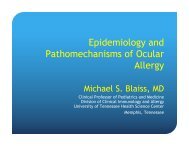Dubai Final-v20.indd - World Allergy Organization
Dubai Final-v20.indd - World Allergy Organization
Dubai Final-v20.indd - World Allergy Organization
You also want an ePaper? Increase the reach of your titles
YUMPU automatically turns print PDFs into web optimized ePapers that Google loves.
ABstrACts<br />
allergy in human. A Burkard spore trap was set for seven days sampling in lebak Bulus, district in south Jakarta, while a passive<br />
collectors with adhesive object glass were placed in Darmaga Bogor, Pasar minggu and Jagakarsa in south Jakarta. Using light<br />
and scanning electron microscopes (sEm), pollens that were trapped and identified were acacia (Acacia auriculiformis), cogon<br />
grass (Imperata cylindrica), coconut (Cocos nucifera), palm trees (Elaeis guineensis), maize (Zea mays), rice (Oryza sativa), and<br />
pine (Pinus merkusii). molecular weight of protein profiles from those pollen extract using sodium dodecyl sulfate-polyacrylamide<br />
gel electrophoresis analysis (sDs-PAgE) were dominated by 10-70 kD bands. Allergenicity in human to those pollen commercial<br />
grasses mix extract was also included in the test to people with and without history of allergy, 69 people each, using the skin prick<br />
test method. the seven pollen of plants trapped in indonesia are allergenic. Human sensitivity to Cogon grass and acacia pollen<br />
are more severe than to the rest of other pollen, however, the sensitivity was most found to commercial allergens of grasses mix.<br />
People with respiratory allergy was more sensitive than people without history of allergy. meanwhile, human sensitivity to acacia<br />
was the same in those two groups of people. Pollen of Cogon grass and acacia are potential allergens to be used for skin prick test<br />
in indonesia. Acacia trees are not recommended to be utilized as a shading tree since their pollen showed sensitivity reaction in<br />
human.<br />
Keywords: pollen, allergen, sensitivity, skin prick test.<br />
1116<br />
inHalanT allErgEnS SEnSiTiZaTion in PaTiEnTS WiTH aSTHma anD allErgiC rHiniTiS; rEViEW oF SKin TEST rESUlTS<br />
oVEr TWo YEarS PErioD aT SUlTan QaBooS UniVErSiTY HoSPiTal, mUSCaT – oman<br />
sharef, s. W. and Al-tamemi, s. H.<br />
Department of Child Health, sultan Qaboos University Hospital, muscat, Oman.<br />
Background: there are geographical variations with respect to allergens presence, and therefore identification of relevant allergens<br />
in each environment is important that may have diagnostic and therapeutic implications.<br />
method: A review of allergy skin prick tests during (April 2008 – march 2010) is performed at sultan Qaboos University Hospital,<br />
muscat - Oman. A new panel of inhalant allergen extracts was introduced in April 2008. Pediatric and adult patients with a<br />
diagnosis of Asthma or Allergic rhinitis (Ar) are referred by physicians for allergy skin tests. the skin prick tests were performed<br />
according to standard method. the data were collected and analyzed using sPss. the frequencies of positive allergens sensitization<br />
were calculated.<br />
results: there were a total of 561 patients with asthma and allergic rhinitis. the number of patients with asthma was 103<br />
(44.7% males and 55.3 % females). in these patients, the most common allergen sensitization is Dermatophagoides pteronyssinus<br />
(44.7%), followed by Dermatophagoides farinae (40.8%), Cat fur (21.4%), Dog Hair (18.4%), russian thistle (14.6%), Bermuda<br />
grass (13.6%), mosquite (11.7%), Feather mix (7.8%), 5 grasses mix (5.8%), Aspergillus mix (5.8%), Chenopodiaceous (5.8%),<br />
Penicillium mix (4.9%), Compositae (4.9%), Date Palm (4.3%), Wheat pollen (3.9%), Cladosprium mix (3.9%), Cattle Hair & Epithelia<br />
(1.7%). the number of patients with allergic rhinitis was 458 patients (53.9% males and 46.1 % females). in these patients, the<br />
most common allergen sensitization is Dermatophagoides pteronyssinus (33.8%), followed by Dermatophagoides farinae (30.1%),<br />
russian thistle (24.7%), Chenopodiaceous (16.6%), Dog Hair (14.6%), Cat fur (12.9%), mosquite (12.9%), Bermuda grass (12.4%),<br />
Date Palm (9.8%), Compositae (7.6%), 5 grasses mix (5.5%), Feather mix (5%), Wheat pollen (4.4%), Cattle Hair & Epithelia (4.3%),<br />
Aspergillus mix (3.3%), Cladosprium mix (2.6%), Penicillium mix (2.4%).<br />
Conclusion: the above data identified House dust mite as the commonest allergen sensitization (which is consistent with published<br />
data from other countries), other significant allergens are identified including date palm pollens. this will help physicians to manage<br />
allergic asthma and Ar patients. Ultimately pollen count may be necessary to identify other significant environmental allergens in<br />
Oman.<br />
1117<br />
SKin PriCK TEST in CHilDrEn rESiDing in a rUral CommUniTY in BanDUng, WEST JaVa, inDonESia<br />
sapartini, g. 1 , B.Kartasasmita, C. 1 , setiabudiawan, B. 1 , majangsari, r. g. D. 1 , saptaputra, W. 2 and irwan, n. 2<br />
1 2 Department of Child Health, school of medicine Padjadjaran University, Bandung, indonesia. Health research Unit, school of<br />
medicine Padjadjaran University, Bandung, indonesia, Bandung, indonesia.<br />
Background skin prick test (sPt) is a fast, safe, and efficient method to diagnose igE-mediated allergy that provides optimal<br />
information as long as it performed and interpreted correctly. it is important that the allergens tested for should be adjusted to<br />
the patient’s clinical condition and residential. the aim of this study is to report the result of sPt in children residing in a rural<br />
community in Bandung, West Java, indonesia.<br />
methods this study was a part of a nested case control study entitled, “rsV and recurrent wheezing in indonesia: 7-9 years<br />
follow-up study with lung function studies.” this study was conducted in Department of Child Health, Hasan sadikin Hospital from<br />
www.worldallergy.org 85<br />
FinAl PrOgrAm<br />
ABstrACts

















